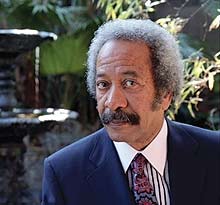
Allen Toussaint
Allen Toussaint has long been one of New Orleans’ most revered artists: a quintuple threat as songwriter, arranger, producer, pianist and singer. The 71-year-old is probably still best known as the writer of such Crescent City classics as “Workin’ in a Coal Mine,” “Ya-Ya,” “Everything I Do Gohn Be Funky,” “Yes We Can Can” and “Java,” but his arranging and production work has transcended city and state borders.
Even before Hurricane Katrina forced him out of New Orleans — exiling him to New York — Toussaint frequently worked outside of his hometown. In fact, just prior to Katrina, he and a number of other top singers — including Ann Peebles, Billy Preston, Mavis Staples and Irma Thomas — recorded the emotion-packed album I Believe to My Soul at Capitol Studios in Hollywood. That disc was produced by roots-oriented singer/songwriter Joe Henry, and then after Katrina, while Toussaint was in New York, he also contributed songs to the superb anthology Our New Orleans, also produced by Henry. In 2006, Toussaint and Henry teamed up with Elvis Costello to make the well-received River in Reverse CD.
Though Toussaint has put out several fine albums under his own name, he is known more as a consummate collaborator, and that reputation is confirmed on The Bright Mississippi — an exquisite, mostly instrumental tour of early blues-influenced jazz. With his sure, inventive piano playing in the foreground, Toussaint and a small group tackle a dozen tunes by the likes of Sydney Bechet, King Oliver, Jellyroll Morton, Django Reinhardt, Thelonious Monk and Duke Ellington.
“This was Joe Henry’s brainchild to do all those wonderful standards: ‘Solitude,’ ‘Day Dream’ and ‘Egyptian Fantasy,’” Toussaint says. “I considered [those songs] very serious and dear, but had traveled on another path.” Henry pitched the project to Toussaint and to Nonesuch Records, and he picked the musicians: clarinetist Don Byron, trumpeter Nicholas Payton, acoustic guitarist Marc Ribot, bassist David Piltch and drummer/percussionist Jay Bellerose, along with special guests Brad Mehldau (piano) and Joshua Redman (tenor sax), on one track each.
Henry says, “I started going through my iPod, and found a lot of material that [Toussaint] could really own or interpret in a very authentic way. We did talk about doing it in New Orleans, but it had much more to do with the musicians I wanted in the room.” The producer picked Avatar Studios in New York because of its large tracking space, where he had the players form a circle around Toussaint’s piano. The live sessions took place March 19 to 22, 2008.
Henry wanted a lot of natural bleed and room ambience, and he specified the use of ribbon mics as much as possible. Other details of recording and equipment were left to engineer/mixer Kevin Killen (Elvis Costello, U2, Peter Gabriel). “The room has such a wonderful sound it’s almost impossible to make a bad-sounding record there,” Killen says. “When I first started out at studios in Dublin, a lot of the sessions were acoustic in nature, but not in the jazz idiom. That part didn’t bother me. I was more concerned about the separation and getting a sense of realization at the same time, especially from putting the drums in the room. Fortunately, the musicians were very good at tempering their dynamics to the sound of the room.”
Among the mics Killen used were Electro-Voice RE-20, Shure SM7 and SM57, Yamaha MS-10 sub kicks, AKG 451 and Coles 4038 (overheads) for drums; for Bellerose’s assorted percussion devices, Neumann KM-84s; for acoustic bass and the guitar, a combo of a KM-86 and Royer 122; for piano, Schoeps CMC 5 and Royer SF-24; trumpet was captured with an RCA 44 and Royer 121; and clarinet with a Neumann U67 and Royer 121. Room mics were Neumann U87s suspended and Royer R-121 on the floor. No outboard preamps were used; everything went directly to the Neve 8088 console, with very little EQ and compression, to Pro Tools.
“The mixing occurred a couple months later at Sevonay Sound in Chelsea,” Killen says, “[though] I had done roughs at Avatar, with the balancing set. I found a basic outline that worked on all the tracks, adding some reverb, and was done in three days. Allen listened to it at Avatar, made some comments, and after several quick adjustments it was done. It was great fun, and I was delighted that everyone thought the record sounded great.”






